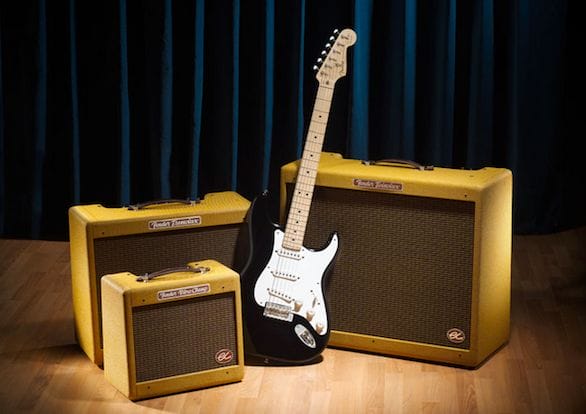Alright, you’re in the market to buy (or sell) a used amp on Craigslist or eBay. How much should you pay for used amp for your guitar? You can search for the name of any amplifier and we’ll crawl the web to tell you the fair used price for it. For those of you that are new to amp buying, Priceonomics contributor Valerie Farabee has created an introductory guitar amp buying guide below.

Image credit: Fender.
Amplify your life – How to choose an amp for your electric guitar
With the aid of the extraordinarily helpful, incredibly awesome Priceonomics guide to buying guitars, you’ve navigated the different types of guitars and settled on an electric. Better yet, you’ve learned the basics on your acoustic guitar and you’re ready to make the kind of noise that only an electric can deliver – but how does one make that sound happen? Introducing your new best friend: the Amplifier.
Enter Amp-Man
A guitar amplifier is an electronic sound amplifier designed to amplify the electrical signal from an acoustic or electric guitar in order to play it through a speaker. In other words: guitar, meet speaker; speaker, meet noise. When playing an electric guitar, especially as a performer, an amp is not optional. Without an amp there is no projected sound, and I project a lot of people leaving a performance where they can’t hear any of the music! Amps are rated by wattage rather than size, and a brand new player should buy a solid-state practice amp under 20W with an 8” or 10” speaker. These are not the highest quality and you will want to upgrade soon, especially if you are playing with other musicians, but it provides an excellent tonal reference point for the beginner.
Oldies and Goodies
There are two basic types of amps to choose from, a tube amp and a solid state amp. Tube amplifiers use a series of antiquated tubes to provide power, distortion, and tone. Solid State amps use transistors, and increasingly different types of software, as well, to provide tone.
When choosing between the different amps, keep in mind what kind of music you’d like to play. The biggest difference between a solid state and a tube amp is the tone you get from each device. If you’re into metal and distortion, a solid state amp is for you. For the warmer tones heard in jazz, blues, or classic rock, a tube amp will rock your world. Tube amps will give you a little more trouble at first and are unforgiving in terms of tonal mistakes, but are a favorite among old school musicians.
Aurally Fixated
So you’ve moved on from the practice amp – now what? When choosing an amp, specifically listen for tone. Tone is a combination of many things: the guitar, the amp, your fingers, your intention when playing, and is absolutely influenced by the style, type and brand of amp you choose to get. If you aren’t confident in your skills as a player, have a salesperson take each amp through its paces to allow you to listen to the sound through the amp. You may not yet be able to play hard, but you’ve been able to hear most of your life: unless you are tone deaf, trust your ears when you are listening to the sound coming through the amp.
Advanced guitarists will look specifically for things like:
- Is the sound clear?
- Are there multiple channels? Does it switch channels cleanly without any pops?
- Does it have inputs for guitars with passive and active pickups?
- Does it have basic controls for volume, bass, middle and high tones?
Entire books have been written about what to look for when buying a guitar amp, so these are just a foundation, just the basics to keep in mind when looking for your first couple of amplifiers!
In terms of power, 10 to 30 watts is all that is really needed. Anything more and hearing loss, your landlord, and the neighbors might become a problem.
The Price is…varied?
Amplifiers are available in a wide range of prices, from $100 to $1,000, and it’s a personal and financial decision as to which one is right for you. If you are still practicing solo, and not performing or playing with other musicians, a less expensive amp might be for you. If you are jamming with a bunch of sweet pros, then keep in mind that that anything under $300 won’t provide you with the pro-tone you’ll be looking for at that point. The priceonomics guide to amps is a great tool for researching the prices of the few amps you’ve cherry picked from your comparison shopping visits to the music stores.
As a beginning musician, choosing an amplifIer is more about getting a sound that will encourage you to keep playing rather than gearing up with the latest and greatest amp on the market. Remember, an amp by any other name is a doorstop if you aren’t using it!
Practice hard, play harder, listen with your ears and choose what you like – you are on your way to rocking and rolling! Rock on!



